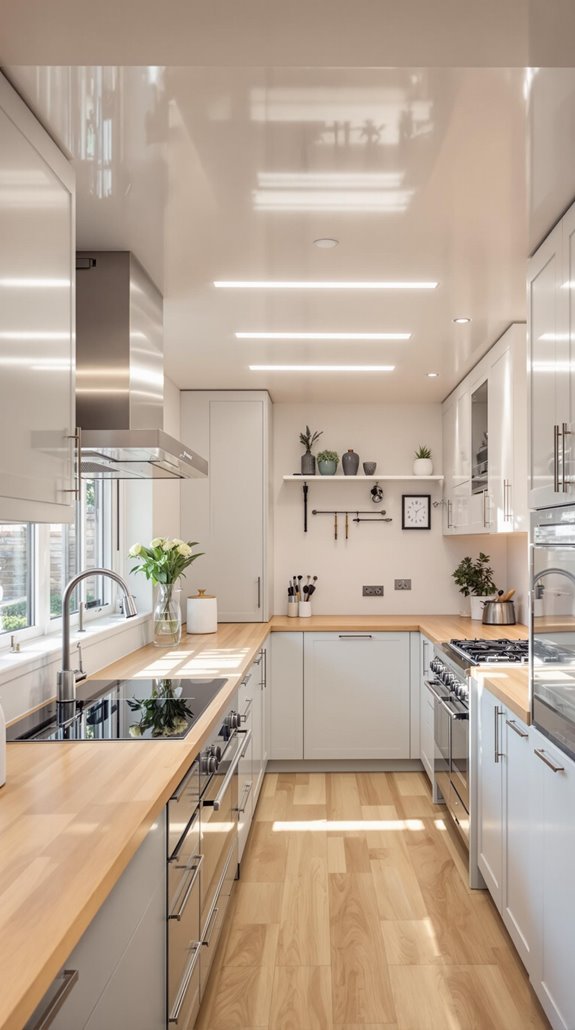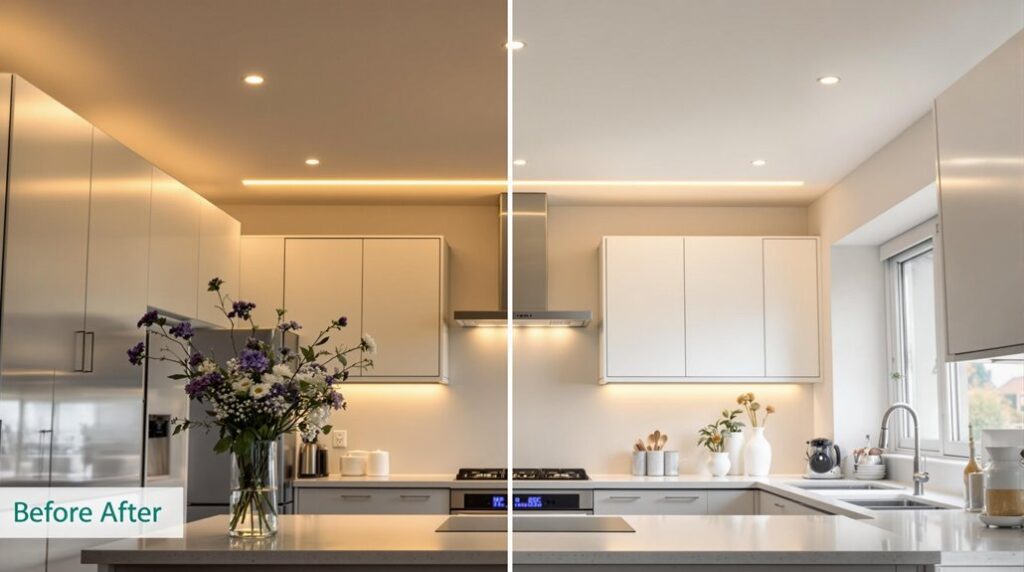I’ve been helping UK homeowners navigate the fluorescent lighting ban, and the savings are substantial—around £13 monthly for just two 58W tubes replaced with LEDs. You’re facing a regulatory deadline that’s actually an opportunity to slash your energy bills while improving your home’s lighting quality. The conversion process isn’t as straightforward as you might think, though. Several critical factors determine whether you’ll need professional installation or can tackle this yourself.
Key Takeaways
- UK fluorescent lighting ban implemented February 2024 makes LED conversion mandatory for homeowners seeking compliant lighting solutions.
- DIY LED conversion saves approximately £13 monthly per two 58W fluorescent tubes with installation costs around £10 per fitting.
- LEDs use 80% less electricity than fluorescent bulbs, offering substantial energy savings with 1-3 year payback periods.
- LED lights contain no mercury, last 25 times longer than conventional bulbs, and improve indoor air quality significantly.
- Government Enhanced Capital Allowance tax incentives available for compliant LED upgrades supporting net zero goals and energy efficiency.
UK Fluorescent Lighting Ban Timeline and What It Means for Homeowners
Since February 2024, the UK has implemented an extensive ban on fluorescent lighting that fundamentally changes how homeowners approach their lighting choices. This ban didn’t happen overnight – it rolled out in phases starting February 25, 2023, with ring-shaped fluorescent lamps and plug-in CFLs, followed by T5 and T8 linear fluorescent lamps in August 2023.
The driving force behind this legislation centers on environmental protection and energy efficiency. Fluorescent lamps contain mercury, a hazardous substance that poses significant environmental and health risks. This ban aligns with the EU’s RoHS directive while supporting the UK’s net zero goals through reduced energy consumption and greenhouse gas emissions. Additionally, homeowners should be aware of hidden costs associated with transitioning to LED alternatives, as they may initially seem more expensive but can lead to savings over time.
For us homeowners, this means we can’t purchase new fluorescent tubes or CFLs anymore, making the shift to LED alternatives essential for our lighting needs. The comprehensive ban affects homes, offices, public buildings, and industrial settings across the UK.
DIY Fluorescent to LED Conversion: Cost Breakdown and Time Requirements
While the UK’s fluorescent lighting ban creates an immediate need for replacement, the DIY conversion to LED technology offers homeowners significant financial advantages and surprisingly straightforward installation requirements.
You’ll save approximately £13 monthly per two 58W fluorescent tubes, with LEDs using one-third the power. Installation costs roughly £10 per fitting including VAT, making the initial outlay comparable to traditional bulbs. This conversion is particularly appealing amid rising energy costs, which have made energy efficiency a priority for many households.
The conversion process involves two types: Type A uses existing ballast, while Type B requires bypassing it. You’ll need basic tools—wire strippers and wire nuts. Simply turn off power, remove fluorescent tubes, and rewire by connecting line and neutral wires to tombstone holders.
Each fixture takes just minutes to convert. Beyond cost savings, you’ll enjoy longer lifespan, mercury-free environmental benefits, and various colour temperature options. LEDs also perform reliably in cold temperatures down to -20°C, making them ideal for unheated spaces like garages and basements.
Professional Installation Services: When to Call an Electrician
Although DIY fluorescent-to-LED conversion offers substantial savings, certain situations demand professional electrical expertise to guarantee safety and compliance. I recommend calling an electrician when you’re dealing with complex ballast bypassing that requires cutting high-voltage wires and installing new sockets. Older magnetic ballasts must be removed entirely for Type B LED tubes, and multi-tube fixtures often involve daisy-chained wiring needing expertise.
You’ll also need professional help for hazardous material handling. Fluorescent tubes contain mercury requiring certified disposal services, and broken tubes release toxic mercury vapor. Commercial buildings face higher disposal costs without professional waste contracts.
Finally, consider professionals for high-ceiling fixtures requiring specialized equipment and when integrating advanced controls like motion sensors or dimmers into your conversion project. Professional installation ensures electrical standards compliance and safety throughout the conversion process.
Energy Savings Calculator: How Much You’ll Save on Electricity Bills
How much will you actually save by switching from fluorescent to LED lighting in your home? I’ll show you exactly how to calculate your savings using key metrics that matter to your wallet.
You’ll need these inputs: number of current fixtures, existing wattage, planned LED wattage, daily operating hours, and your electricity rate (typically £0.10 per kWh in the UK). The calculator compares annual consumption in kWh between both lighting types, showing yearly cost differences and payback periods.
LEDs use 80% less electricity than traditional bulbs, plus they eliminate fluorescent warm-up delays and reduce cooling costs through lower heat output. You’ll also benefit from higher color rendering and reduced maintenance frequency, making the switch financially smart for any UK homeowner. The longer lifespan of LEDs can be up to 25 times greater than conventional bulbs, dramatically reducing replacement costs over time.
Fluorescent Vs LED Performance Comparison and Total Cost Analysis
When comparing fluorescent and LED lighting systems, the performance gap becomes immediately apparent through measurable metrics that directly impact your home’s operating costs. I’ll break down the key differences that matter most to UK homeowners.
LEDs deliver 2-5 times longer lifespan (25,000-50,000+ hours) versus fluorescents (10,000-20,000 hours), eliminating frequent replacements. You’ll notice instant full brightness without warm-up delays or flickering that plague fluorescent tubes. LEDs also provide superior directional lighting that minimizes wastage compared to fluorescent bulbs that scatter light in all directions.
The total cost analysis reveals compelling savings: while a 58W fluorescent costs 1.44p/hour at current UK rates, an equivalent 45W LED runs just 1.12p/hour. Factor in reduced maintenance, no ballast failures, and mercury-free disposal, and your payback period typically falls within 1-3 years through utility savings alone.
Compliance Benefits: Meeting UK Building Regulations and Environmental Standards
Five major regulatory changes now make LED upgrades mandatory rather than optional for UK homeowners. Since August 2023, T5/T8 fluorescent lamps can’t be placed on the UK market, with T8 variants (18-58W, 70W) fully prohibited. February 2024 brought production and import bans for mercury-containing fluorescent lamps, while high-pressure sodium lamps face phase-out by February 2027.
These regulations are crucial in promoting energy efficiency, which can significantly reduce overall energy costs for homeowners. I’ll help you navigate these compliance requirements effectively. Your LED conversion eliminates mercury hazards completely, reducing workplace safety risks during maintenance. You’ll achieve Part L building regulation targets through LED’s ≤80% lower power consumption compared to fluorescent equivalents. This transition away from fluorescent technology represents a significant shift from lighting systems that have remained largely unchanged since the 1930s. Emergency lighting compliance becomes straightforward—fluorescent EXIT signs are now prohibited, but LED upgrades guarantee you meet BS 5266 standards while avoiding penalties during building safety inspections.
Step-by-Step Guide to Replacing Garage and Workshop Fluorescent Tubes
Before you begin replacing your garage fluorescent tubes, you’ll need to prioritize safety and understand your existing setup. I always disconnect the mains power first – it’s non-negotiable for preventing electric shock. Remove your existing tube by rotating it 90 degrees and sliding downward from the holders.
Next, I identify the ballast type. If there’s a starter, remove it entirely – LED tubes don’t need it. Choose LED tubes matching your original length and pin configuration. I recommend starter-based LEDs for conventional ballasts or ballast-bypass types for electronic systems. Insulating your garage can also improve energy efficiency, which complements your lighting upgrade.
Install by inserting the LED tube pins into holders and rotating 90 degrees to lock. Verify the LED strip faces downward for ideal light dispersion. You’ll experience immediate start-up without the flicker or delay that’s common with fluorescent lighting. Restore power and test – you’ll instantly notice the improved brightness and energy savings.
Mercury-Free LED Technology: Health and Environmental Advantages
Beyond the straightforward installation process, LED technology offers significant health and environmental advantages that make the switch from fluorescent lighting particularly compelling for UK homeowners. Unlike fluorescent tubes, LEDs contain no mercury—a neurotoxin that poses serious health risks when released through broken bulbs. I’ve seen firsthand how mercury contamination requires specialized cleanup and creates indoor air quality concerns, particularly dangerous for children and elderly family members. Additionally, making the switch to LEDs aligns with cost-effective measures to improve home energy efficiency, ultimately leading to lower energy bills.
From an environmental perspective, LEDs eliminate mercury’s toxic impact on soil and water systems. Their recyclable components support sustainable practices, while their 50,000+ hour lifespan dramatically reduces waste compared to fluorescents’ 1,200-1,600 hour life. Additionally, LEDs produce light without flickering, creating a more comfortable visual environment that reduces eye strain and headaches commonly associated with fluorescent lighting. You’re not just upgrading your lighting—you’re protecting your family’s health and contributing to environmental preservation through mercury-free technology.
Future-Proofing Your Home Lighting Against Regulatory Changes

As UK lighting regulations tighten dramatically over the next few years, upgrading to LED technology now protects your investment from costly retrofits and compliance issues. I’ll explain why acting today saves you significant hassle tomorrow.
The government’s pushing minimum luminous efficacy to 140lm/W by September 2027, effectively ending fluorescent lighting entirely. Your home must meet EPC rating “C” or higher by 2028, and non-compliance carries real penalties including insurance invalidation. This is crucial as energy-efficient choices can significantly lower your overall energy consumption.
If you’re renting out property, MEES requirements hit even harder. New rentals need compliance by 2025, existing tenancies by 2028. Smart lighting integration becomes mandatory under updated building regulations through 2025. The government offers Enhanced Capital Allowance tax incentives to help offset the costs of upgrading to compliant LED systems.
Conclusion
I’ve shown you the clear financial and regulatory benefits of switching from fluorescent to LED lighting in your UK home. You’ll save approximately £13 monthly per two 58W tubes while complying with upcoming bans. Whether you’re tackling a DIY conversion or hiring an electrician, you’re investing in mercury-free technology that’ll future-proof your home. Don’t wait—start your fluorescent replacement project today and begin enjoying immediate energy savings.
References
- https://www.tr-register.co.uk/forums/index.php?/topic/86045-how-much-does-it-cost-to-change-a-light-bulb/
- https://www.morrisdirect.co.uk/blogs/advice-centre-led-lighting/why-leds-are-better-than-fluorescent-lights
- https://www.myjobquote.co.uk/costs/installing-light-fittings
- https://www.simplyled.co.uk/blog/uk-and-eu-ban-on-fluorescent-tubes-and-compact-fluorescent-light-bulbs/
- https://www.verivide.com/the-eu-and-uk-fluorescent-bulb-ban/
- https://www.bltdirect.com/the-ban-on-fluorescent-tubes
- https://www.designplan.co.uk/fluorescent-lamp-ban/
- https://www.cils.uk/fluorescent-lighting-ban-is-your-business-prepared/
- https://thecompliancepeople.co.uk/updates/news/fluorescent-lamps-end-of-an-era/
- https://www.eenergy.com/insights/navigating-the-t5-and-t8-fluorescent-lighting-ban-a-comprehensive-guide-for-educational-institutions/

